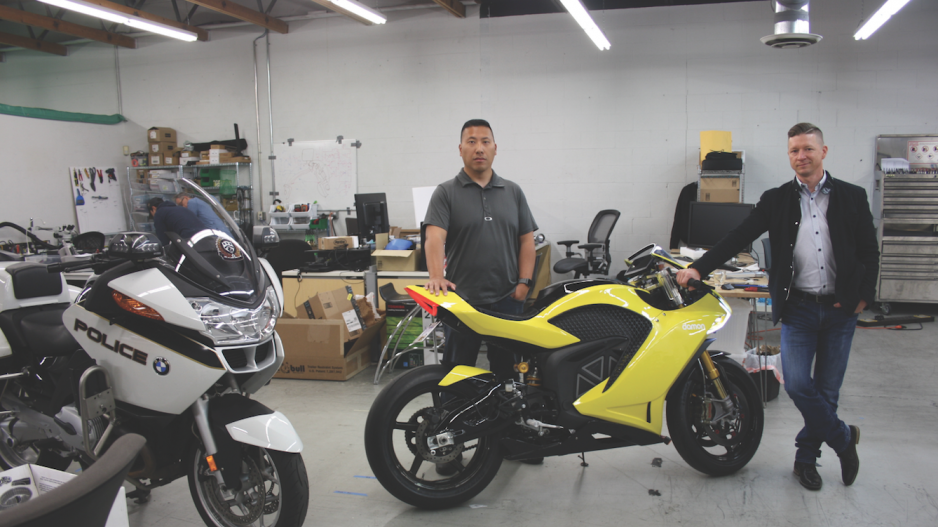A small array of motorcycles, including a West Vancouver Police Department bike, sits nestled in the second storey of a wood-panelled Mount Pleasant office building.
After some retrofitting they’ll be ready to depart the facility safer for riders than when they entered.
With 3D printers humming in the background and a team of experts installing small cameras and sensors onto the bikes, Damon Motors Inc. CEO Jay Giraud inspects his company’s bright yellow “Halo” motorcycle with co-founder and chief technology officer Dom Kwong.
“Cars have forward collision systems, and they have blind-spot detection systems,” said Giraud, who launched his third vehicle-related startup in April 2017 after departing from Mojio. “On motorbikes it’s totally non-existent, which seems really strange. Motorcyclists otherwise have to rely on the awareness of the drivers, and the No. 1 thing that drivers say when they hit a motorcyclist is ‘I just didn’t see the bike.’”
With drivers sometimes struggling to notice riders before it’s too late, Damon’s safety systems aim to give motorcyclists one last tool to avoid the worst-case scenario.
For example, if a rider has to turn his or her head to check a blind spot when changing lanes, the sensors will send vibrations to the handlebars to alert the rider if there’s any danger.
Meanwhile, small cameras in the back of the bike provide the rear-view-mirror angle riders previously didn’t have access to.
Giraud said the plummeting cost of small sensors and cameras is making it financially viable to tap into the market for motorcycle safety systems, targeting organizations’ fleets with the capacity to afford large-scale retrofits.
Last month, Damon announced a partnership with the West Vancouver Police Department to retrofit its fleet with these systems (the West Vancouver Police Department did not acknowledge requests for comment from Business in Vancouver).
“Every successful startup, to no small extent, is a product of timing,” Giraud said. “We have that convergence of the maturity of these technologies to come together, and on top of that Damon uses AI [artificial intelligence] both on the bike and in the cloud so that our motorcycles can learn from each and every incident that they see.”
The play for data will also become increasingly valuable, with Giraud describing the system as a black box that can help determine what happened in an accident.
“These types of technologies are definitely the future of insurance,” said Aaron Sutherland, the Insurance Bureau of Canada’s Pacific region vice-president.
This summer the Insurance Corp. of British Columbia (ICBC) is set to launch a yearlong telematics pilot involving as many as 7,000 new drivers who agree to submit data that’s recorded while they drive.
Telematics uses hardware and software to monitor a vehicle’s location, its speed or even how frequently it brakes or turns.
It’s different from the technology Damon has developed, but both can be used by insurance companies to monitor drivers.
ICBC plans to use a small in-vehicle device to communicate with an app on a driver’s smartphone to record driving habits.
Based on the data collected, the insurance carrier would then produce a score for the driver.An earlier pilot suggested that more than 40% of participants improved their driving after the implementation of telematics in their vehicles.
“It would help me enormously as a teaching tool in terms of not overloading students, and using nudges and reminders,” said Dat Louie, a motorcycle instructor at Pacific Riding School who consulted with the team at Damon.
He said one of the biggest risks riders face is procedural drift, when complacency creeps into their riding habits, and they become less vigilant about the road dangers. Louie said Damon’s alerts would help reduce these dangers, especially as distracted driving has become more common with the advent of smartphones.
“If it means we see less injury cases, we’re all for that,” said Vancouver lawyer Martin Spieker, partner at McNeney McNeney Spieker LLP.
Spieker, whose firm specializes in motorcycle accidents, said the data collected by this technology would be helpful, but he doesn’t see it changing the way legal cases are handled in B.C.
“In these liability tort cases we do, the motorists answer under oath … ‘I didn’t see them [or] know that they were there,’” he said. “There’s only one possible explanation, which is that their brain is just not registering, and that is a human factor. It’s something that technology could assist in keeping cyclists and motorcyclists safer.”




